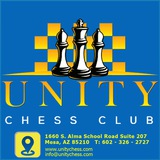Is Black defending? No, his pieces are tied up, and White has a pair of passed pawns, which are ready to promote.
He has to bring the rook into the game in this way, but Black does not solve his problems.
Unity Chess Club
Alexander Kotov Gedeon Barcza Stockholm 1952 White to move
All the black pieces are extremely passive, and the Na7 creates a sad impression also. Not surprisingly, as well as possibilities of increasing the pressure gradually, White has an energetic decision:
22...Qe6 23.Bxg7 Nxg7 24.Qg5 Qe5 25.Nh6+ Kh8 26.Qxe5 dxe5 27.Rxd8 Rxd8 28.Nxf7++–.
This move had to be foreseen earlier – here, the bishop is invulnerable, also preventing moves by the black f-pawn, and a mating attack on the dark squares is inevitable.
The white pawn calmly advances to h6, as the black pieces need too much time to come to the aid of their king.
